In the realm of learning disabilities, dyslexia stands out as one of the most widely recognized and discussed conditions. However, the question of whether it is the most common learning disability warrants a deeper exploration. To understand this issue comprehensively, it is imperative to delve into the nuances of dyslexia, other learning disabilities, prevalence rates, diagnostic criteria, and the broader context of education and neurodiversity.
Defining Dyslexia: Understanding the Complexity
Dyslexia is a neurodevelopmental disorder characterized by difficulties in reading, spelling, and decoding words. Individuals with dyslexia may experience challenges in phonological processing, rapid automatized naming, working memory, and other cognitive functions associated with language processing. Despite these difficulties, dyslexia does not reflect a lack of intelligence or motivation; rather, it is a specific learning difference that affects the acquisition of literacy skills.
The Landscape of Learning Disabilities
While dyslexia garners significant attention, it is not the only learning disability that affects individuals. Other common learning disabilities include dyscalculia (difficulties in mathematical reasoning), dysgraphia (challenges with writing), attention-deficit/hyperactivity disorder (ADHD), specific language impairment (SLI), and auditory processing disorder (APD), among others. Each of these conditions presents unique challenges and impacts on learning and daily functioning.
Exploring Prevalence Rates
Determining the prevalence of learning disabilities, including dyslexia, is complex due to variations in diagnostic criteria, assessment methods, and population demographics. However, studies suggest that dyslexia is indeed prevalent, with estimates indicating that approximately 5% to 10% of the population worldwide may have dyslexia. Despite its prevalence, dyslexia often remains underdiagnosed or misidentified, leading to inadequate support and intervention for affected individuals.
Challenges in Diagnosis
Diagnosing dyslexia involves comprehensive assessment by qualified professionals, including educational psychologists, speech-language pathologists, and special education teachers. However, the lack of standardized diagnostic protocols and the overlap of symptoms with other conditions can pose challenges. Additionally, cultural and linguistic factors may influence the identification and interpretation of dyslexia symptoms, highlighting the need for culturally responsive assessment practices.
Addressing Misconceptions
One common misconception about dyslexia is that it solely manifests as difficulty in reading and spelling. While these are hallmark features, dyslexia encompasses a broader range of cognitive and linguistic difficulties. Individuals with dyslexia may also struggle with comprehension, organization, time management, and other aspects of academic and daily life. Recognizing the multifaceted nature of dyslexia is crucial for implementing effective support strategies.
The Role of Early Intervention
Early identification and intervention are key to mitigating the impact of dyslexia on academic achievement and psychological well-being. Evidence-based interventions, such as structured literacy instruction, phonological awareness training, and assistive technology, can help individuals with dyslexia develop compensatory strategies and build literacy skills. By addressing dyslexia early, educators and parents can empower individuals to reach their full potential and thrive academically and personally.
Beyond Dyslexia: Embracing Neurodiversity
While dyslexia receives considerable attention, it is essential to recognize that neurodiversity encompasses a broad spectrum of cognitive differences, strengths, and challenges. Embracing neurodiversity involves fostering inclusive environments that celebrate individual differences and accommodate diverse learning styles and needs. By promoting acceptance and understanding, society can create pathways for all individuals to contribute meaningfully and participate fully in education and society.
Conclusion
In conclusion, while dyslexia is a prevalent and significant learning disability, it is not the only one that impacts individuals’ educational journeys and life experiences. Understanding the complexities of dyslexia, including its prevalence, diagnosis, and intervention, is essential for supporting affected individuals effectively. Moreover, embracing neurodiversity and recognizing the diversity of learning profiles within the population can foster inclusive environments and promote equity in education and beyond. As we continue to advocate for individuals with learning disabilities, let us strive for greater awareness, acceptance, and accessibility to ensure that every individual has the opportunity to thrive and succeed, regardless of their cognitive differences.


